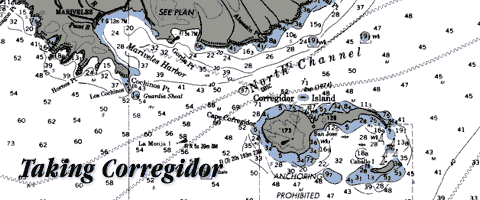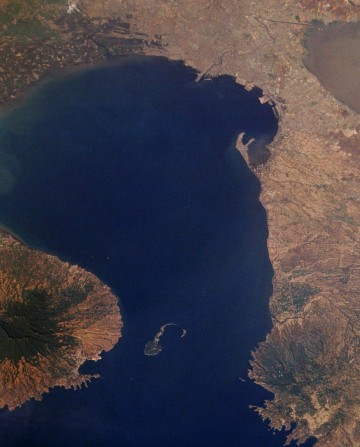|
| ||||||||||
13–16 February 1945 — Manila Bay
Manila Bay—30 miles across—in 1992, looking easterly with the city of Manila at top right, Corregidor at lower center, and Mariveles Harbor on the Bataan Peninsula at lower left. Click to view this image in more detail. |
After the landings at Lingayen (the Nicholas had led a 550-ship armada with Gen. MacArthur in the cruiser Nashville) we stood south to bombard and retake Manila Bay: Bataan, Mariveles, Carabao, El Fraile, and, of course, Corregidor.
Our destroyer task group was based in Subic Bay, two hours up the coast from Manila Bay. At 0330 each morning for four days, we stood out of Subic Bay and steamed south, arriving in Manila Bay two hours later, just before dawn. Our task was to soften up Corregidor as much as possible before the paratroopers went in for the final clean-up. I did not envy them.
We bombarded Corregidor as long as it was daylight. For two days, the Nicholas and others steamed close to the cliffsides, point-blank-range close, to draw Japanese fire from the tunnel openings. The idea was to find the guns and silence them. But we had to give the Japanese first shot.
The scheme worked. We were shot at continually and we silenced quite a few of those cliffside guns.
Fortunately, the Nicholas was not hit. One shell exploded close enough to wound a seaman in the throat. All in all, the Nicholas led a charmed life during World War II.
Because it was a continuing fight, we stayed at battle stations all day every day. We took individual breaks for meals. Breakfast and supper were served during the two-hour run between Subic and Manila. Dinner was not served as such. Each unit in the ship sent one or two men at a time to eat. We ate in a hurry and hastened back to our battle stations. Mine was on the bridge, so I was witness to much of the action.
At the end of each day, an hour or so after sunset, we steamed north to Subic Bay, arriving at 2200. It was no time for rest. We had to refuel and replenish ammunition for the next day's action. We never went out unless fully loaded. As a result, we hit the sack about 0100 for an all-too-brief two- to three-hour sleep.
None of us ate well, of course, and I don't remember showering during those four days. I didn't want to give up my sleep time. Besides, who cared what we smelled like. We always smelled of sweat and diesel fuel smoke anyway.
The whole Corregidor operation took four days, 13–16 February 1945.
Before Corregidor, the Nicholas had participated in the Leyte Gulf action, and in the landings at Lingayen Gulf, Luzon.
After Corregidor, the Nicholas participated in the landings at Zamboanga, Cebu, Borneo, and Okinawa, and, finally, the Japanese surrender in Tokyo Bay.
— Doug Starr
|



